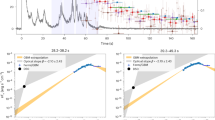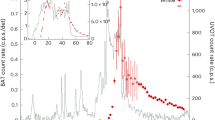Abstract
The origin of γ-ray bursts (GRBs) has been enigmatic since their discovery1. The situation improved dramatically in 1997, when the rapid availability of precise coordinates2,3 for the bursts allowed the detection of faint optical and radio afterglows — optical spectra thus obtained have demonstrated conclusively that the bursts occur at cosmological distances. But, despite efforts by several groups4,5,6,7, optical detection has not hitherto been achieved during the brief duration of a burst. Here we report the detection of bright optical emission from GRB990123 while the burst was still in progress. Our observations begin 22 seconds after the onset of the burst and show an increase in brightness by a factor of 14 during the first 25 seconds; the brightness then declines by a factor of 100, at which point (700 seconds after the burst onset) it falls below our detection threshold. The redshift of this burst, z ≈ 1.6 (refs 8, 9), implies a peak optical luminosity of 5× 1049 erg s−1. Optical emission from γ-ray bursts has been generally thought to take place at the shock fronts generated by interaction of the primary energy source with the surrounding medium, where the γ-rays might also be produced. The lack of a significant change in the γ-ray light curve when the optical emission develops suggests that the γ-rays are not produced at the shock front, but closer to the site of the original explosion10.
This is a preview of subscription content, access via your institution
Access options
Subscribe to this journal
Receive 51 print issues and online access
$199.00 per year
only $3.90 per issue
Buy this article
- Purchase on Springer Link
- Instant access to full article PDF
Prices may be subject to local taxes which are calculated during checkout


Similar content being viewed by others
References
Klebesadel, R. W., Strong, I. B. & Olson, R. A. Observations of gamma-ray bursts of cosmic origin. Astrophys. J. 182, L85–L88 (1973).
Piro, L. et al. The first X-ray localization of a γ-ray burst by BeppoSAX and its fast spectral evolution. Astron. Astrophys. 329, 906–910 (1998).
Costa, E. et al. Discovery of an X-ray afterglow associated with the γ-ray burst of 28 February 1997. Nature 387, 783–785 (1997).
Krimm, H. A., Vanderspek, R. K. & Ricker, G. R. Searches for optical counterparts of BATSE gamma-ray bursts with the Explosive Transient Camera. Astron. Astrophys. Suppl. 120, 251–254 (1996).
Hudec, R. & Soldán, J. Ground-based optical CCD experiments for GRB and optical transient detection. Astrophys. Space Sci. 231, 311–314 (1995).
Lee, B. et al. Results from Gamma-Ray Optical Counterpart Search Experiment: a real time search for gamma-ray burst optical counterparts. Astrophys. J. 482, L125–L129 (1997).
Park, H. S. et al. New constraints on simultaneous optical emission from gamma-ray bursts measured by the Livermore Optical Transient Imaging System experiment. Astrophys. J. 490, L21–L24 (1997).
Kelson, D. D., Illingworth, G. D., Franx, M., Magee, D. & van Dokkum, P. G. IAU Circ. No. 7096 (1999).
Hjorth, J. et al. GCN Circ. No. 219 (1999).
Fenimore, E. E., Ramirez-Ruiz, E., Wu, B. GRB990123: Evidence that the γ-rays come from a central engine. Preprint astro-ph/9902007 at 〈http://xxx.lanl.gov〉 (1999).
Barthelmy, S. et al. in Gamma-Ray Bursts: 4th Huntsville Symp. (eds Meegan, C. A, Koskut, T. M. & Preece, R. D.) 99–103 (AIP Conf. Proc. 428, Am. Inst. Phys., College Park, (1997).
Piro, L. et al. GCN Circ. No. 199 (1999).
Odewahn, S. C. et al. GCN Circ. No. 201 (1999).
Bloom, J. S. et al. GCN Circ. No. 208 (1999).
Katz, J. I. Low-frequency spectra of gamma-ray bursts. Astrophys. J. 432, L107–L109 (1994).
Mészáros, P. & Rees, M. J. Optical and long-wavelength afterglow from gamma-ray bursts. Astrophys. J. 476, 232–237 (1997).
Sari, R. & Piran, T. The early afterglow. Preprint astro-ph/9901105 at 〈http://xxx.lanl.gov〉 (1999).
Bertin, E. & Arnouts, S. SExtractor: Software for source extraction. Astron. Astrophys. Suppl. 117, 393–404 (1996).
Høg, E. et al. The Tycho reference catalogue. Astron. Astrophys. 335, L65–L68 (1998).
Monet, D. et al. A Catalog of Astrometric Standards (US Naval Observatory, Washington DC, (1998).
Zhu, J. & Zhang, H. T. GCN Circ. No. 204 (1999).
Bloom, J. S. et al. GCN Circ. No. 206 (1999).
Gal, R. R. et al. GCN Circ. No. 207 (1999).
Sokolov, V. et al. GCN Circ. No. 209 (1999).
Ofek, E. & Leibowitz, E. M. GCN Circ. No. 210 (1999).
Garnavich, P., Jha, S., Stanek, K. & Garcia, M. GCN Circ. No. 215 (1999).
Zhu, J. et al. GCN Circ. No. 217 (1999).
Bloom, J. S. et al. GCN Circ. No. 218 (1999).
Maury, A., Boer, M. & Chaty, S. GCN Circ. No. 220 (1999).
Zhu, J. et al. GCN Circ. No. 226 (1999).
Sagar, R., Pandey, A. K., Yadav, R. K. R., Nilakshi & Mohan, V. GCN Circ. No. 227 (1999).
Masetti, N. et al. GCN Circ. No. 233 (1999).
Bloom, J. S. et al. GCN Circ. No. 240 (1999).
Acknowledgements
the ROTSE Collaboration thanks J. Fishman and the BATSE team for providing the data that enable the GCN localizations which made this experiment possible; and we thank the BeppoSAX team for rapid distribution of coordinates. This work was supported by NASA and the US DOE. The Los Alamos National Laboratory is operated by the University of California for the US Department of Energy (DOE). The work was performed in part under the auspices of the US DOE by Lawrence Livermore National Laboratory. BeppoSAX is a programme of the Italian Space Agency (ASI) with participation of the Dutch Space Agency (NIVR).
Author information
Authors and Affiliations
Corresponding author
Rights and permissions
About this article
Cite this article
Akerlof, C., Balsano, R., Barthelmy, S. et al. Observation of contemporaneous optical radiation from a γ-ray burst. Nature 398, 400–402 (1999). https://doi.org/10.1038/18837
Received:
Accepted:
Issue Date:
DOI: https://doi.org/10.1038/18837
This article is cited by
-
Observations of a very energetic ultraviolet and optical flare with a space telescope
Nature Astronomy (2023)
-
An intense visible flash from a distant gamma-ray burst
Nature Astronomy (2023)
-
Prompt-to-afterglow transition of optical emission in a long gamma-ray burst consistent with a fireball
Nature Astronomy (2023)
-
An optical–ultraviolet flare with absolute AB magnitude of −39.4 detected in GRB 220101A
Nature Astronomy (2023)
-
Exceptionally bright optical emission from a rare and distant gamma-ray burst
Nature Astronomy (2023)
Comments
By submitting a comment you agree to abide by our Terms and Community Guidelines. If you find something abusive or that does not comply with our terms or guidelines please flag it as inappropriate.



